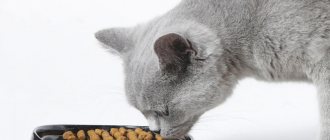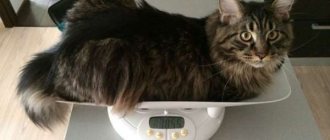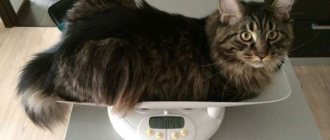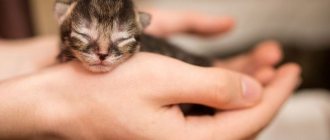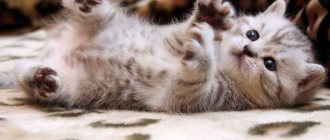Kittens weight
After the baby is born, you can see how strong and big he will grow.
For a newborn British kitten, the normal weight is in the range of 70-130 g. Already in the second week, the kitten can reach a weight of 150 g. In two weeks, the baby grows almost one and a half times, which means that it is the first period of his life that will greatly influence the future sizes.
The main thing is to pay enough attention to nutrition. A cat that feeds growing offspring must be well fed with high-calorie food and vitamins in order to be able to fully feed the kittens with milk.
After the second week, the baby already weighs 210 g - this is the average. However, a kitten can weigh much more - 450 g (upper norm). He becomes more active, his eyes may even open.
At the end of the first month of life, complementary foods can be introduced. It is permissible to feed the baby with boiled and finely chopped beef and canned cat food, sea fish, chicken, cottage cheese (a very useful product for strengthening bones) and hard-boiled eggs (yolks only).
In the first month of development, the kitten should grow to 250 g, although a normal weight is even 600 g. Well, in two months, depending on heredity and nutrition, the kitten will weigh from 700 g to 1.5 kg.
Over the course of three months of life, the kitten must gain at least 1 kg of weight. If not, he may have a health problem or is not getting enough nutrition.
During this period, the kitten can become almost 100 g heavier every day. A cat at this age should weigh in the range of 1-1.5 kg, and a cat - 1.5-2 kg.
If babies are still fed breast milk, they need to introduce vitamins and a more varied diet into their diet. It is not recommended to give them smoked meats, pork and other fatty meats, fatty cottage cheese, river fish and, most importantly, meat with bones. The best option is canned cat food with a good range of vitamins and nutrients.
After 4 months of life, cats gain up to 1.7-2.4 kg, and males - from 2.1 to 3.9 kg. The pet becomes even more like an adult animal. If his weight exceeds 4 kg, it is necessary to reduce the amount of food, since a cat that begins to gain weight at an early age may have many health problems in the future. It may be worth contacting a veterinarian - he will prescribe the right diet and vitamins.
After five months of life, the male cat should weigh 2.6-4.5 kg, and the male cat should weigh 2.2-2.9 kg. Before becoming an adult cat, the pet will have to gain the same amount of mass.
At the sixth month of life, the kitten develops fairly strong teeth. Sexual development begins. It would also be a good idea to think about preventing worms. The quantity and food for kittens can be gradually reduced.
In the seventh month, the pet may shed hair, especially if it spends a lot of time outside. Hairballs appear everywhere, which the kittens regurgitate.
At the eighth month of a kitten’s life, the owner is faced with the question of whether to castrate/sterilize or not. It is better to carry out this procedure for cats at the 8th month, for cats - no later than a year.
In the ninth month you need to get vaccinated. They are already sufficiently formed so that medication does not have a detrimental effect on them.
At the tenth month of life, food for adult cats should be introduced into the diet, and the children's menu should be abandoned. Now they can be given dry food.
At the age of 11-12 months of life, kittens begin to play actively, stop creating inconvenience for others and like to often release their claws. The weight of cats at one year of age and in adulthood is given below (castration/sterilization also plays a role).
Table
What are the dangers of obesity?
You can tell that a cat is obese by its sagging belly. Because the fat layer is too thick, the costal and vertebral bones cannot be felt. An obese animal moves slowly and ignores active activities.
ATTENTION! An obese cat needs to be examined at a veterinary clinic for prevention, as there is a high probability of developing diseases of the heart and vascular system, as well as inflammation of the joints.
Excess weight greatly affects the health of a British pet. The most common pathologies:
- increased blood pressure, development of atherosclerosis;
- lethargy, powerlessness, drowsiness;
- hormonal disbalance;
- blurred vision due to increased intraocular pressure;
- development of diabetes;
- the appearance of gout, osteoarthritis;
- disruption of the digestive tract;
- hard breath;
- thirst;
- deterioration of metabolism;
- weakening of the immune system.
Parameters of an adult cat
After the cat has grown and formed, its weight should be from 2.5 to 5.5 kg, and that of the cat - from 4.5 to 8 kg. At this stage of life, weight also depends on “additional” procedures: for example, a sterilized cat can gain up to 6 kg, and a cat can gain up to 9 kg.
British cats reach their adulthood and stop gaining weight at 3-4 years of age. It is worth noting that cats with solid colors tend to have a higher body weight than “patterned” British cats, and this is normal.
You can determine whether a cat has a normal weight by simply feeling it lengthwise: the pet’s subcutaneous layer of fat should be barely noticeable and lightly cover the ribs, which provides good thermal insulation without reducing mobility and activity. The presence of fat in the intercostal spaces indicates that the cat is overweight. It is worth remembering that the British are strong and powerful animals, quite large, but by no means fat.
Is it possible to identify a Briton by his behavior?
The character of a British cat is also a serious marker of the species in question. It begins to manifest itself in childhood, and over time acquires all the required features:
- autonomy and independence;
- desire to be alone;
- habit of sleeping a lot;
- tolerates long absence of the owner from the house without any problems.
All basic character parameters can be adjusted only in childhood, but you should not expect that the British dog will become sociable, affectionate and strive for constant communication with the owner.
In the early period, ground rules for living together are laid down and red lines for unacceptable behavior are drawn. If everything is left to chance, the kitten will eventually turn into an aggressive cat that will bite, scratch and make its own rules in the house.
Why is it important to control your pet's weight?
Caring owners must keep a diary of their kittens' weight from the very first days of their life. This allows you to monitor the development of your pet. It is very difficult to control based on visual parameters: that is why the measurement is based on weight. It is recommended to have accurate electronic scales in the house and weigh babies every day in the first weeks of life, and later - at least once a week. The weight of a newborn baby must be at least 60 grams, otherwise you should immediately contact a veterinarian. Such a baby must be fed with special care in the future.
Meeting all family members
Children love animals very much and show great interest in them. Tell your child how to properly pick up a cat, how he shows his dissatisfaction by wagging his tail, and that you shouldn’t squeeze him too hard and drag him around the house.
Perhaps you have another animal at home? Then you should initially not introduce the new guy to the old one for a couple of days. The new one will still get used to it, but the old resident will already feel the emergence of a new one.
At the same time, pay sufficient attention to both the first and second pet so that jealousy does not arise. Arrange a meeting with them in a few days
They need to be in the room at this moment, and each of them should have a place to retreat, in case something happens. If an undesirable reaction occurs, limit contact with the animals for a couple of days and introduce them again.
Why doesn't the animal gain weight?
During the early stages of life, a kitten should gain weight very quickly, so the owner can easily notice any growth problems, especially compared to other kittens. If the kitten is not growing, you should pay attention to the following reasons:
- In the case of a large litter (more than five kittens), the baby may not have enough mother's milk or even a free nipple. It is worth paying attention to how well and often he eats, and also apply it to his mother’s nipple yourself.
- If all the kittens are actively suckling their mother, but are growing poorly, it is worth increasing the amount of food for the mother, adding vitamins and calories.
- If everything is fine with nutrition, but the kittens are still not gaining weight, they should be taken to the veterinarian
Proper nutrition and a sufficient amount of vitamins are the basis for the normal and rapid development of a pet. If the weight of babies at a certain stage of life differs greatly from the indicators given in the table, you should consult a veterinarian.
Tips for maintaining normal weight
To keep a British cat's weight within normal limits, owners need to maintain a balanced diet:
- add a small percentage of cereals and vegetables to dry and soft food;
- add boiled vegetables to the food (various varieties of cabbage, beets);
- meat and fish should only be lean, they should be included in the menu daily;
- Among the cereal products, it is best to give your cat oatmeal, millet, and rice;
- You need to cook porridge for your pet in water, without adding sugar and salt.
A kitten is taught to eat cereals and vegetables from an early age. The diet of an adult British cat should consist of 10–15% vegetables and cereals, 85–90% meat and fish.
Also, we must not forget about regular physical activity. To prevent a cat from developing obesity, the owner must engage it in active games every day.
High-quality and balanced nutrition, an abundance of vitamins and nutrients, an active lifestyle - these are the main factors for the full development of a British pet.
The owner should weigh the kitten at the same time every day in order to notice weight deviations in time. If the development of the “British” does not correspond to his age, then there is no need to hesitate in going to the veterinarian.
Source
First moult and grooming
A kitten's first shedding occurs at seven or eight months of age. During the week, the kitten should be carefully combed every day with a special comb, running through the fur with massage movements. After this procedure, you can walk over the fur with your hand in a wet rubber glove, thus collecting the remaining fur. Subsequent molting occurs on an individual basis, depending on many factors - vitamin deficiency, allergic reactions, existing diseases, age-related and hormonal changes, and the use of inappropriate bathing products.
Regular grooming of the British dog's coat with special combs will preserve the beauty of the coat.
You need to groom your pet regularly:
- weekly brushing will bring many benefits to your pet. Firstly, this procedure will rid the cat of dead skin particles and fur hairs, which means that when licking, less of them will end up in the stomach. Secondly, regular brushing gives the animal a healthy and well-groomed appearance;
- if you accustom your kitten to water procedures from an early age, then bathing can become one of your pet’s favorite activities, which can be used both when soiled and for preventive measures;
- Careful trimming of the claws will rid the pet of the rough, keratinized part, which flakes off over time, causing the claws to begin to cling and cause discomfort to the cat. The procedure is short, only a couple of times a month. The haircut is carried out with special scissors, carefully so as not to damage the blood vessel;
- regular preventive examination of the auricle and organs of vision, when the cat’s ears are cleaned of wax accumulation, and the eyes are wiped with black tea infusion or eye drops.
From an early age, a kitten needs to be accustomed to the necessary procedures, then he will calmly endure them and even enjoy them
How to brush British cats?
Before purchasing a British kitten, you should buy special combs at a pet store. To care for your pet you will need:
- a comb with metal teeth with rounded ends so as not to injure the animal’s skin. Needed for primary combing of wool of any length in the direction from head to tail according to hair growth;
- comb with massage effect. Stimulates blood circulation, provides beautiful fur for your pet by combing out dead skin particles and dead hairs. You need to comb your pet with such a comb carefully so as not to damage the delicate undercoat;
- rubber brush or glove. Helps complete your pet's grooming routine. With the help of such a brush you can remove remaining hairs from the surface of the coat after active combing.
A variety of pet grooming products to choose from allows you to keep your cat's coat healthy and beautiful.
Bathing
The first bath of a kitten should be careful and not earlier than one month of age, so as not to scare the baby and not instill a negative impression of the procedure. It is better to teach the kitten to bathe in a playful way, touching the kitten with wet hands, and then gently moistening the baby’s fur with a few drops of warm water. This way, the kitten won’t get scared and won’t start to struggle, and the water, rolling off the fur, will attract attention and interest.
Gradually, with the help of play, the kitten will get used to the water and will allow its body to be completely wet, while you can also gradually begin to use special shampoos that do not have a strong odor. The only exception can be shampoos against parasites, the pungent smell of which can scare away the “British”. Bathing a pet kept in an apartment should not be done more than once every two months, unless treatment or severe contamination of the animal forces it to be done more often.
What do you need to know? The shampoo should be selected based on the length of your pet’s coat and its color, as some products are designed to enhance the color of the animal’s coat.
A kitten's first bath should be no earlier than one month of age.
Bathing stages:
- fill the container with water, adjusting its temperature (about 30 °C);
- pour a special shampoo into the water that suits your pet;
- place the cat in a container with soapy water and gently, massaging the fur, wet the cat’s body;
- rinse off the product with clean warm water, being careful not to get it into your ears, they are very sensitive;
- After bathing, wrap the cat in a dry towel to thoroughly dry the wet fur;
- Place your pet in a warm, draft-free room.
If you gradually accustom your kitten to water procedures, then over time he will enjoy the process and will not be capricious.
Three months
From this age until six months, small and furry comrades should gain 100 grams per day. It is at this time, and especially if the pet is separated from its mother, that it is very important to feed the pet a balanced diet.
He also needs various vitamins. It is from three months that experts advise owners to finally decide what they will feed their four-legged friend (see the weight of a kitten at 3 months). This can be high-quality dry or wet food or natural food prepared specifically for the animal.
You should not combine both in your diet. If the owners of a kitten buy him premium food, then from it he receives a sufficient amount of essential proteins, fats, minerals and vitamins, so if you feed him something else, this may cause an overabundance of all nutrients. In addition, all this can cause excess weight in a male or female.
Visual inspection
To determine the condition of the animal, it is necessary to carefully examine its physique. The condition of the limbs and abdomen is determined when looking at the profile, the lumbar region and waist are assessed when viewed from above. The weight of a cat can also be “calculated” by manual palpation. To do this, the area of the ribs is felt with your fingers. Moreover, if the bones stick out at the slightest pressure, then the animal is malnourished; if you need to make an effort to palpate them, then, most likely, the pet is obese.
After the ribs, the waist and abdomen area is assessed
In cats, it is very sensitive, so you must be careful when palpating. If you run two palms from the waist to the pelvic bones, you should get an hourglass shape
If this sensation does not arise, then the cat is most likely overweight.
Next, the abdomen is examined. Softness should be felt under your fingers. But if it hangs down a lot or is swollen, then nutritional adjustments are necessary. A sunken belly indicates a lack of nutrition or illness.
Birth
In general, cat pregnancy lasts about 56-63 days. The period depends on the breed for many other reasons. It is impossible to say exactly how long cats are pregnant or how long gestation lasts. Factors influencing duration:
- Weight.
- Presence of previous attacks.
- The relationship between the time of the first estrus and mating.
It is advised to breed a female cat on her third heat, trying to avoid protracted previous periods. If the pet is taken to a partner earlier, the animal will bear kittens for about 50 days. The babies may appear premature or dead.
The weight of the pet is also important when determining the timing of the cat's death. Small beauties, weighing about 3 kg, bear kittens faster, how long do small British cats walk before permission is known. Cubs appear earlier, at 55-56 days. Large adult, sedentary individuals migrate at 64-65 days and can walk beyond the established period.
How many kittens an animal gives birth to depends on the time at which the process occurs; a British cat brings no more than three babies for the first time. Typically, primiparous cats are delivered on time at 63 days. Labor lasts approximately 2 to 14 hours.
It often happens that there is only one kitten in the first litter. And this is from mating with a pet, which can produce up to 7-8 babies. There is no need to be afraid and try to stimulate the appearance of more: each animal’s body has its own characteristics
It is not so important the number of litters a cat produces from the first time, and how many kittens the British favorite will give birth to. You need to worry about the condition of the animal and offspring
https://youtube.com/watch?v=e46QkC4Ao7c%3F
When to start - tips
Small pets should not be taken away from their mother too early. The main reason for this rule: the baby must be fed breast milk and will learn hygiene skills from an adult cat. The optimal age for moving to another family is 3 months, the cub will be about 12 weeks old.
Smell and touch are the main helpers of a kitten in the first days of birth. The baby does not hear or see yet: he finds his mother’s warm side and nipple by smell. The organs of vision begin to function 10-14 days after lambing. In many ways, the opening of the eyes depends on gestation, that is, on how long the cat carried the kitten. Premature babies will develop the ability to see later. Those born later will see the world faster.
The development of female pets is more intensive. The girl's eye slits become wider earlier than those of her furry brothers. The breed of the animal also matters. British Shorthairs will open their eyes on the 6th day after birth. And for long-haired breeds, the process of restoring visual activity can take up to 14 days.
In a dark place, the formation of the ability to see will take longer. The deadline has passed, but the baby is still blind. You can help him to open his eyes faster. On the advice of veterinarians, an antibacterial medicine is instilled and the eyes are washed with strong tea and a solution of boric acid.
Regardless of the breed, all babies, including British newborns, have blue-gray eye color. The shell will acquire its characteristic final shade only after 6 months. When kittens open their eyes after 6 days of birth, the habits of the inquisitive baby change.
Development in the third week
During the third week, all kittens' eyes open. However, vision is not yet good enough to navigate in space. It is necessary to monitor all physiological changes to ensure that the development of kittens corresponds to their age and to promptly eliminate irritating factors that may interfere with normal growth.
The main stages of development of newborn kittens take place in the first three weeks, as their body is actively growing and all the organs of smell and touch are formed. It is at the age of three weeks that kittens first try to stand on their paws and their teeth appear.
The formation of the jaw will take up to two months. From the third week, you can safely accustom the baby to your hands, constantly play with him and stroke him, and in order to let the pet know that the owner is also one of his friends, in addition to the other kittens and the mother.
Results
After a year, it turns into an adult, care for which includes the following procedures:
- regular visits to the veterinarian; timely vaccination; timely nutrition, properly selected diet; care for hair, teeth and nails.
If you pay due attention to the upbringing of your pet, then the development of the pet, both on the physical and psychological levels, will go quite smoothly and you will receive an obedient and pliable pet that will delight you with its appearance and friendliness throughout its life.
Source


